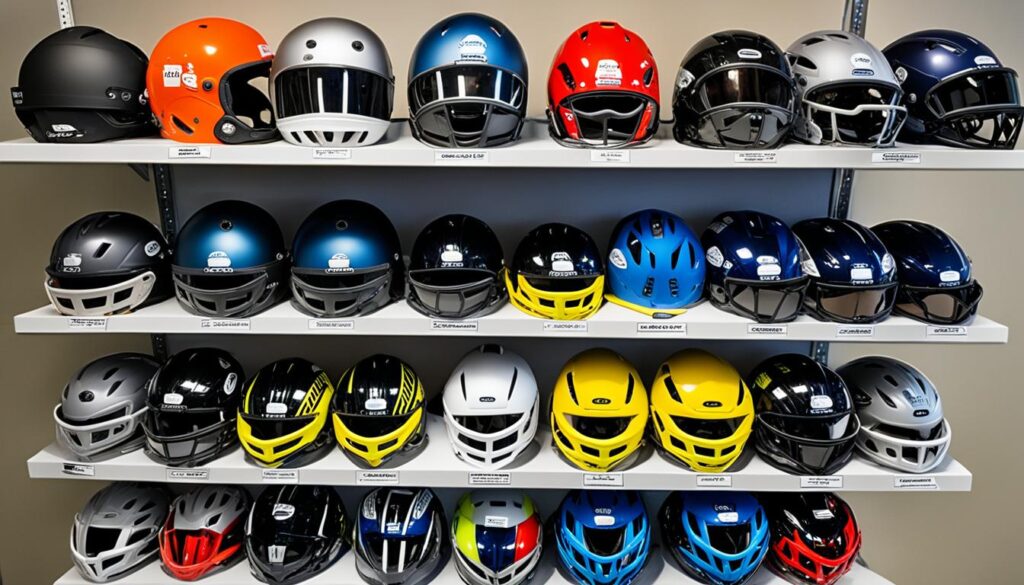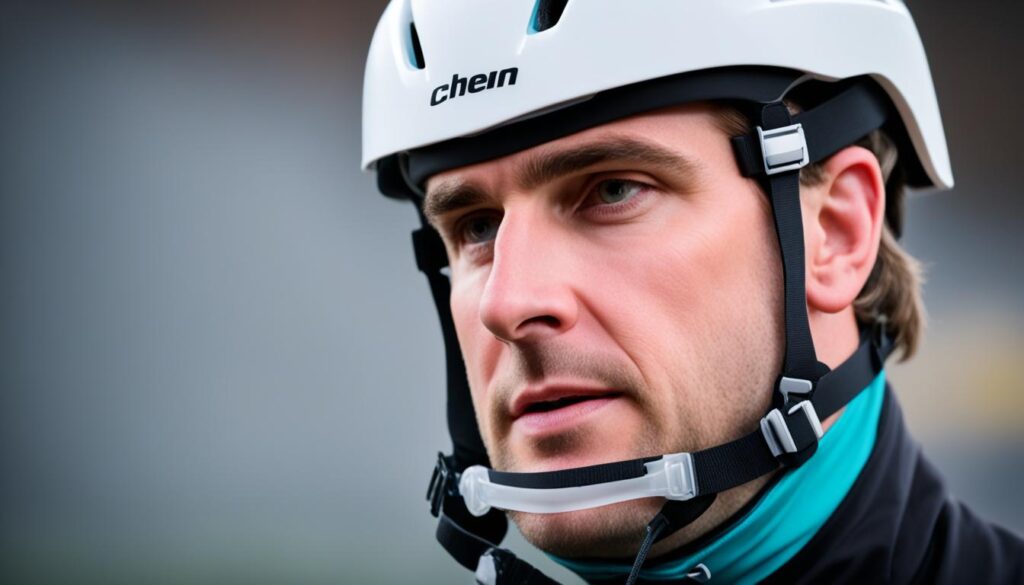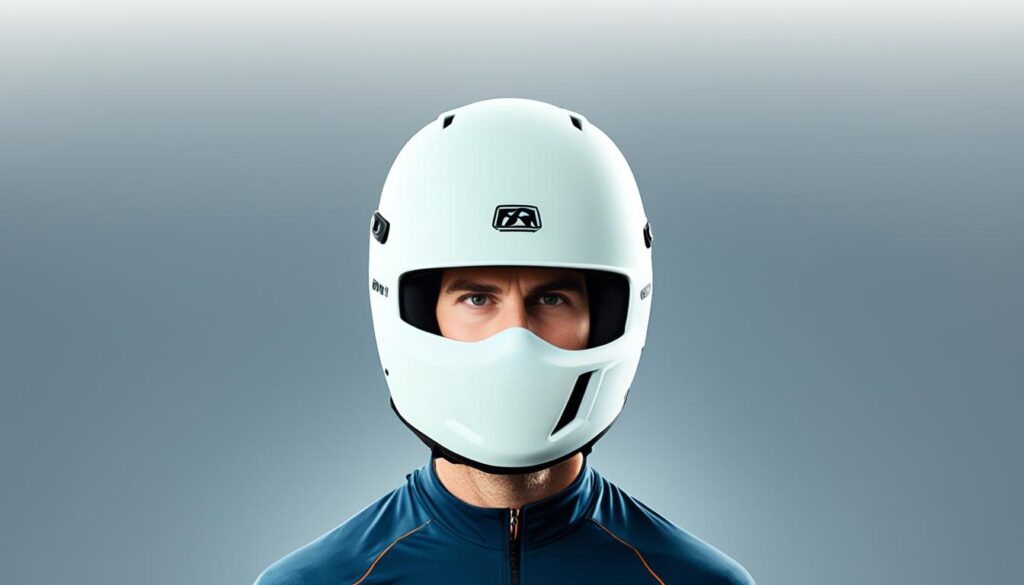
Have you ever wondered if your helmet is really providing you with the best protection? Do you know the correct way to measure your helmet size? And how do you achieve the ideal fit that ensures both safety and comfort?
Finding the right helmet size can be a daunting task, but it’s crucial for your safety on the road or trail. In this article, we’ll guide you through the process of measuring your helmet size, understanding helmet size charts, and adjusting the fit to achieve the best helmet fit for you.
Key Takeaways:
- Proper helmet fit is essential for performance and safety during an impact.
- The circumference of the head should be measured at specific points to determine the right size.
- Helmet size charts provide useful references for choosing the correct size.
- Adjusting the helmet to achieve a snug but not constricting fit is crucial.
- Consider special considerations, advanced technologies, and variations in head shape for the perfect helmet fit.
Why Proper Helmet Fit Matters
A properly fitted helmet is essential for ensuring maximum protection during an accident. When it comes to helmet safety, size matters. Wearing a loosely fitting helmet increases the risk of it not staying in place, which can lead to a head injury. On the other hand, an excessively tight-fitting helmet can be uncomfortable and unsafe. That’s why finding the right helmet fit is crucial for your safety.
Consulting a helmet size guide for safety is a great starting point. These guides provide valuable information on measuring your head and selecting the appropriate helmet size. Additionally, following helmet fitting tips can help you ensure a proper fit. Tips may include adjusting the straps, ensuring the helmet sits low on the brow, and providing a snug but not constricting fit.
Another helpful resource is considering helmet size recommendations. Different helmet brands may have variations in sizing, so it’s important to explore their recommendations based on your measurements. This can help you choose the correct size and ensure a secure and comfortable fit.
Proper helmet fit is not just about comfort, but also about your safety. Take the time to find the right size, follow fitting tips, and consult size recommendations. Your head deserves the best protection.
Why a Proper Helmet Fit is Important:
- Ensures maximum protection during an accident
- Reduces the risk of the helmet not staying in place
- Prevents discomfort and unsafe conditions
Remember, a properly fitted helmet is a crucial component of your safety gear. Investing time in finding the right fit can make all the difference in protecting your head during any outdoor activity.
How to Measure Helmet Size
Properly measuring your helmet size is crucial to finding the right fit for optimal comfort and protection. To accurately measure your head circumference, use a small metal or cloth tape measure. Place the tape measure above your eyebrows and take the measurement at the largest point at the back of your head. It’s essential to take multiple measurements and choose the largest one when trying on helmets.
If you plan to wear a balaclava or head sock under your helmet, be sure to take measurements with it on to ensure a proper fit. Proper helmet sizing techniques also involve considering the shape of your head. Different helmets may be designed to accommodate specific head shapes, so it’s important to find a helmet that suits your individual needs.
Manufacturers often provide sizing charts that correlate head circumference measurements to helmet sizes. These charts can be valuable references in determining the best size for your helmet. By following the manufacturer’s sizing guidelines, you can select the appropriate helmet size based on your measurements. Remember, the goal is to find a helmet that provides a snug yet comfortable fit, without excessive pressure points.
Properly measuring your helmet size and following the manufacturer’s sizing chart are essential steps in finding the right helmet fit. By doing so, you can ensure optimal safety and comfort while cycling, giving you peace of mind on every ride.
Helmet Size Charts
When it comes to finding the perfect helmet fit, helmet size charts can be a valuable tool. These charts provide a helpful reference in determining the right helmet size for your head. Different brands may have variations in their size notation and sizing charts, so it’s important to refer to the specific brand’s chart.
Helmet size charts can display measurements in different ways. Some helmets use a range of head diameters, while others may offer size options such as small, medium, and large. By consulting the manufacturer’s chart, you can determine the appropriate size for your head circumference.
Consider the diameter range for each helmet size when using the chart. This information will guide you towards the best helmet fit for your head. Remember, a well-fitting helmet is crucial for both comfort and safety.
Helmets not only protect your head, but they also provide confidence and peace of mind during your rides.
Take advantage of the guidance offered by helmet size charts to ensure the best fit. By finding the right size, you can select a helmet that offers optimal protection and the most comfortable fit possible.
Additional Tips for Choosing the Right Helmet Size
- Measure your head circumference accurately using a small metal or cloth tape measure.
- Take measurements at a point just above your eyebrows and at the back of your head where it is largest.
- Refer to the specific brand’s sizing chart to determine the appropriate size.
- Consider the shape of your head when choosing a helmet to ensure a secure fit.
By utilizing helmet size charts and following these tips, you can confidently find the right helmet size that provides the best fit and protection for your cycling adventures.
Adjusting Helmet Fit
Once you have determined the appropriate helmet size, it is crucial to ensure a proper fit by making necessary adjustments. Follow these helmet fitting tips to achieve the best helmet fit:
- Wear the helmet low on the brow, with the eyes near the center of the eye opening for optimal visibility.
- Fasten the chin strap securely, making sure it is snug but not constricting.
- Ensure that the helmet provides adequate peripheral vision, allowing you to see your surroundings.
- Utilize the adjuster on the rear of the helmet to tighten the cradle or adjust the band running around the helmet circumference.
- The fit should be snug, with uniform pressure around the head, but not excessively tight.
- The helmet should be stable and not able to rotate in any direction.
By adjusting the helmet fit using these proper helmet sizing techniques, you can achieve the best helmet fit, optimizing comfort and safety on your rides.
“A properly adjusted helmet ensures maximum protection and comfort during your cycling adventures.”
Remember, proper fit is vital for the best helmet performance, regardless of the helmet brand or model. Take the time to adjust your helmet correctly, and enjoy a safe and comfortable ride!

Special Considerations
When fitting a helmet, it’s essential to consider some special factors to ensure the right fit. By taking these considerations into account, you can enhance your helmet fitting experience and find the perfect size for optimal comfort and safety.
Hair and Headgear
If you have long hair, it’s crucial to choose a helmet that can accommodate a ponytail. Some helmets come with specific features or adjustments to cater to this need. However, not all helmets may have this feature, so it’s important to check before making a purchase. Additionally, thin hats or cycling caps can be worn under helmets if needed. These headgear options can provide extra insulation or sun protection, as long as they don’t alter the fit of the helmet.
Note: It is advised to avoid wearing a beanie or hood under a helmet for safety reasons, as they can impact the helmet’s fit and compromise its effectiveness in protecting your head.
Kids’ Helmet Size Guides
When choosing a helmet for children, it’s essential to refer to the brand’s size guides. Brands often provide specific sizing recommendations for kids’ helmets, taking into account their head circumferences. Measuring a child’s head circumference accurately is crucial to ensure the correct fit and optimal protection. Following the manufacturer’s guidelines can help you find the perfect helmet size for your child’s safety.
Finding the right helmet size is essential for optimal helmet performance and your safety. By considering these special factors and following helmet fitting tips, you can ensure a secure and comfortable fit that protects you during your rides.
Advanced Helmet Technologies
Helmets have evolved with advanced technologies to enhance safety and protection for cyclists. One such technology is the MIPS (Multi-directional Impact Protection System) liner.

MIPS helmets are designed to reduce rotational forces on the head during an impact. These helmets have an outer shell that can rotate independently of the cradle, allowing the force to be redirected away from the head. This innovative technology has been proven to be effective in reducing the risk of head injuries.
“The MIPS liner allows the helmet to dissipate rotational forces during a crash, reducing the potential for brain injuries.” – Dr. Emily Wilson, Helmet Safety Expert
In independent safety tests, MIPS helmets consistently perform well and demonstrate their ability to provide enhanced protection. However, it is important to remember that even with advanced technologies, a proper helmet fit is crucial.
Adjustments may be required to ensure a secure and comfortable fit when using helmets with advanced technologies. The helmet should still be worn low on the brow, with the eyes near the center of the eye opening. The chin strap should be securely fastened, and the fit should be snug but not constricting. These adjustments help ensure that the benefits of advanced technologies are maximized, providing the best helmet fit possible.
The Benefits of Advanced Technologies
- Reduced rotational forces during impacts
- Enhanced protection against head injuries
- Proven performance in independent safety tests
- Increased confidence and peace of mind for cyclists
Cyclists can rely on helmets with advanced technologies to provide an additional layer of safety. By combining the best helmet fit with these advanced features, riders can enjoy their journeys with peace of mind, knowing they have taken the necessary precautions to protect their heads.
Helmet Fit and Shape Variations
When it comes to helmet fit, there are factors beyond just size that can affect how well a helmet fits an individual. Like cycling shoes, helmets can have different shapes from one brand or model to another. What fits one person perfectly may not fit another person as comfortably.
It is important to try on different helmets to find the perfect fit that considers both size and shape. Each head is unique, and finding a helmet that suits your individual preferences and needs is crucial for the best helmet fit.
Some helmets may have a rounder shape, while others may have a more oval shape. Certain helmet brands may cater to specific head shapes, so it’s worth exploring different options to find the ideal fit. Trying on helmets from different brands and models will allow you to determine which one provides the most comfortable and secure fit for your head shape.
Remember, finding the right helmet size is just the beginning. Ensuring the helmet’s shape matches your head shape is equally important. A helmet that fits properly and matches your head shape will provide the best helmet fit, ensuring comfort and maximum protection during your rides.
Conclusion
Finding the perfect helmet fit is essential for the safety and comfort of cyclists.
Measuring the head, using size charts, and adjusting the fit of the helmet are crucial steps in the process. It is important to consider special considerations such as head shape, advanced technologies like MIPS liners, and variations in helmet fit.
By following the helmet sizing guide and considering these factors, cyclists can ensure they have the best helmet fit for maximum protection during their rides.
Recommended

Meet James Smith, affectionately known by friends as ‘Biker Smith’, your go-to expert at ‘Best HD Helmet Camera’. At 35, living in the USA, James embodies the spirit of adventure. His life is a thrilling ride, powered by his Harley Davidson Softail and BMW S 1000 RR, with his girlfriend as his favorite travel companion. A software developer by profession, James’s heart beats for the open road, making him a full-time traveler at heart. His passion for biking and technology merges seamlessly on this platform. Recognizing a gap in discussions around helmet cameras, he founded this blog to educate and inspire fellow enthusiasts. His mission? To elevate your riding experience with the best HD helmet camera insights, backed by firsthand experiences, rigorous testing, and a genuine love for the ride. Trust James to guide you through the world of helmet cameras, where quality, innovation, and safety ride together.